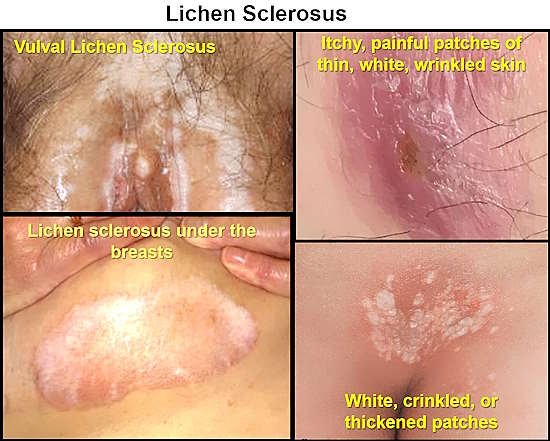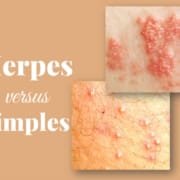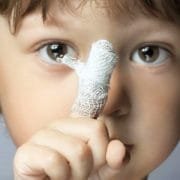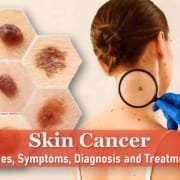Lichen Sclerosus: Causes, Symptoms & Treatment
You might not have heard of lichen sclerosus unless you or someone close to you has experienced it. This is largely because it primarily affects the genital area, which is typically covered by clothing.
Lichen sclerosus is a rare, chronic skin condition that leads to itchy, painful patches of thin, white, wrinkled skin. In women, it often appears on the vulva and around the anus, while in men, it typically affects the head of the penis. The condition can cause discomfort during sexual activity and urination.
Since lichen sclerosus is a long-lasting disease, it can persist for life. However, treatments are available that can ease symptoms and slow the disease’s progression. Unfortunately, many people may go undiagnosed for years, as they feel too embarrassed to discuss their symptoms with a doctor. Early detection and treatment are crucial to prevent long-term issues like persistent itching and genital scarring.
What is Lichen Sclerosus?
Lichen sclerosus is a long-term inflammatory skin condition that mainly affects the genital and anal areas, particularly in young girls and older women. Historically, it has been known as lichen sclerosus et atrophicus, kraurosis vulvae (in women), and balanitis xerotica obliterans (in men). It can cause white, thin, and fragile skin, leading to itching, pain, and scarring. While the exact cause is unclear, it may be linked to the immune system. Though rare, untreated lichen sclerosus can increase the risk of developing skin cancer in the affected area. Diagnosis is usually based on appearance and sometimes confirmed with a skin biopsy. Managing the condition involves regular treatment and follow-up to prevent complications.
Who is Affected by Lichen Sclerosus?
This condition can develop at any age but is most frequently diagnosed in women over 50. It can also affect pre-pubertal children.
- Women are about ten times more likely to be affected than men.
- Approximately 15% of patients have a family history of lichen sclerosus.
- It may occur alongside other skin conditions such as lichen simplex, psoriasis, and erosive lichen planus.
- There is a significant association with autoimmune diseases like thyroid disorders, pernicious anemia, and alopecia areata, affecting around 20% of patients.
How Common is Lichen Sclerosus?
Lichen sclerosus is relatively rare, affecting between 1 in 1000 to 1 in 300 people. It is more common in women, with a female-to-male ratio ranging from 1:1 to 10:1. The condition can present at any age but typically peaks in young girls (8-13 years) and women in their 50s and 60s. It predominantly affects the genital skin, with extragenital involvement being less common.
Causes of Lichen Sclerosus
The exact cause remains unclear but may involve genetic, hormonal, irritant, traumatic, and infectious factors.
- It is often categorized as an autoimmune disorder, with many patients having antibodies to extracellular matrix protein-1 (ECM-1).
- Male lichen sclerosus is rare in men circumcised in infancy, suggesting a possible link to chronic irritation from urine.
- In postmenopausal women, decreased estrogen levels might contribute.
Lichen Sclerosus Symptoms
Lichen sclerosus often begins with small, pink or white bumps that evolve into patchy, wrinkled, and thin white skin, resembling tissue paper. These areas are typically itchy and painful, and the fragile skin can bleed even with gentle scratching.

Genital Symptoms
- Vulval Lichen Sclerosus: Commonly presents as white, crinkled, or thickened patches on the perineum, labia minora, clitoral hood, and sometimes the anal area. Symptoms include intense itching, soreness, pain during intercourse, and discomfort during urination or bowel movements. Scarring may cause clitoral burying, labial shrinkage, and vaginal tightening.
- Penile Lichen Sclerosus: Usually affects the glans penis, leading to white, firm patches. Complications include urethral narrowing (meatal stenosis) and foreskin tightening (phimosis), which may result in painful erections and sexual difficulties.
Extragenital Symptoms
In less common cases, lichen sclerosus can appear on other body areas such as the thighs, buttocks, lower back, and under the breasts, manifesting as white, dry, wrinkled plaques similar to cigarette paper.
Rarely, lichen sclerosus may also involve the oral mucosa, causing lesions inside the mouth. About 15-20% of individuals with genital lichen sclerosus experience symptoms in other body areas, while around 6% have lesions only on non-genital skin.
Complications of Lichen Sclerosus
Infections: Patients with lichen sclerosus are susceptible to infections such as Candida albicans, herpes simplex, and Staphylococcus aureus. Herpes infections, in particular, can be painful, potentially leading to vulval ulceration.
Squamous Cell Carcinoma (SCC): Lichen sclerosus in anogenital areas is linked to a higher risk of developing SCC, with an estimated 5% of patients with vulval lichen sclerosus potentially developing this type of cancer. The risk is greater when inflammation is poorly controlled. Invasive SCC often appears as a persistent, non-healing sore or an enlarging lump. Extragenital lichen sclerosus does not typically increase cancer risk.
Diagnosis
A skilled clinician can often diagnose lichen sclerosus based on its appearance, sometimes supplemented by dermoscopy. A skin biopsy may be required to confirm the diagnosis, rule out other conditions, or check for cancer or high-grade squamous intraepithelial lesions (SIL).
Treatment Options
General Care: Patients should consult a specialist for diagnosis and treatment. Regular gentle washing, avoiding tight clothing, and applying emollients to soothe dry, itchy skin are essential.
Topical Steroids: The primary treatment involves ultrapotent steroids, such as clobetasol propionate, applied once daily. As symptoms improve, the frequency may decrease. Proper use minimizes side effects like skin thinning or fungal infections.
Other Topical Treatments
- Intravaginal estrogen: Helps postmenopausal women with atrophic vulvovaginitis.
- Calcineurin inhibitors: Tacrolimus and pimecrolimus can be alternatives to steroids but may cause initial burning.
- Retinoids: Though not well tolerated in genital areas, they help in non-genital regions to reduce scaling and dryness.
Oral Medications: For severe cases unresponsive to topical treatments, systemic options include corticosteroids, retinoids, methotrexate, and ciclosporin.
Surgical Interventions: Surgery may be required for cancer or severe adhesions. In men, circumcision can be effective, while women might need procedures like perineotomy or perineoplasty to alleviate severe scarring and restore function.
Experimental Treatments: Emerging therapies include laser ablation, phototherapy, and injections of fat or stem cells, though these are still under investigation.
Regular follow-ups and adherence to treatment plans are crucial to managing symptoms and preventing complications.
Lifestyle and Home Remedies for Lichen Sclerosus
These self-care strategies may help reduce skin irritation and discomfort:
- Moisturize Regularly: Apply petroleum jelly or similar products like Vaseline or Aquaphor to soothe and protect the affected area.
- Gentle Cleansing: Wash the area gently with mild, unscented soap daily and pat dry. Avoid over-washing to prevent additional irritation.
- Comfort Baths: Take soothing baths twice daily in lukewarm water to relieve burning and pain. Avoid adding bubble bath or other irritants.
- Control Itching: An oral antihistamine at bedtime can help manage itching and improve sleep quality.
- Use Soft Toilet Paper: Choose unscented, dye-free toilet paper to minimize irritation.
- Avoid Irritants: Steer clear of tight clothing, scented detergents, and other potential irritants to protect sensitive skin.
Outlook for Lichen Sclerosus
Prognosis: Lichen sclerosus is a chronic condition that can persist for years. Extragenital cases are more likely to resolve than anogenital ones. Early treatment may sometimes result in remission, but scarring remains permanent. Long-term follow-up is essential to manage the disease, optimize treatment, and detect cancer early.
Recovery Timeline: Recovery varies based on treatment:
- Topical corticosteroids: Improvements may take several weeks.
- Phototherapy: Results might appear after several sessions, potentially taking up to two months.
- Circumcision: Recovery can take about 10 days, with activity restrictions for both children and adults.
- Urethroplasty: Requires a catheter for 3-4 weeks post-surgery.
Lichen Sclerosus Prevention
While lichen sclerosus cannot be prevented, symptoms can be managed with lifestyle adjustments:
- Maintain a gentle skincare routine using mild soap and moisturizers.
- Wear loose-fitting clothes and avoid irritants like wool or silk.
- Use lukewarm water for baths/showers, avoid bubble baths, and promptly change out of wet clothes.
- Limit activities that cause friction, such as cycling or horseback riding.
Early circumcision may lower the risk of developing lichen sclerosus.
Living With Lichen Sclerosus
Expectations: Most individuals respond well to treatment, though symptoms can recur. Scarring might cause discomfort during urination or sexual activity. Men with urethral involvement should seek early treatment to prevent extensive scarring. Regular checkups are crucial to monitor for signs of squamous cell carcinoma.
Dietary Considerations: No specific diet is recommended, but dietary changes may help alleviate symptoms. Consulting a healthcare provider for tailored advice is beneficial.
When to See a Doctor: Seek medical advice for any new symptoms or if symptoms return after treatment. Regular appointments help in early detection of complications, including cancer.
Emergency Situations: Visit the ER if lichen sclerosus causes complete urinary blockage.
Questions for Your Doctor
- How can you confirm my diagnosis of lichen sclerosus?
- What are my treatment options and their potential side effects?
- Is it safe to engage in sexual activity?
- Should I consult a specialist like a dermatologist?
By understanding the condition and following medical advice, individuals can manage lichen sclerosus effectively and maintain a good quality of life.
Frequently Asked Questions About Lichen Sclerosus
Is Lichen Sclerosus Cancerous?
Lichen sclerosus is not cancer, but it can increase the risk of developing certain types of cancer, such as vulvar squamous cell carcinoma or penile cancer. Regular checkups with a healthcare provider are essential for monitoring changes. If you notice unusual skin changes, referring to lichen sclerosus pictures can help you identify potential issues early, but always seek professional advice.
Is Lichen Sclerosus an STI?
Lichen sclerosus is not a sexually transmitted infection and isn’t contagious. However, because it can mimic the appearance of an STI, abstaining from sexual activity until a diagnosis is confirmed is advisable. The condition may also cause discomfort during sexual activity, and some wonder, does lichen sclerosus smell? While it doesn’t typically have a specific odor, poor hygiene or secondary infections might contribute to an unpleasant smell.
Can I Have Sex If I Have Lichen Sclerosus?
Yes, but sexual activity can exacerbate irritation. Using condoms or internal condoms can help protect sensitive skin. Incorporating lichen sclerosus self-care routines, like using gentle, non-irritating cleansers and moisturizers, can help manage symptoms and reduce discomfort during intimacy.
Is Lichen Sclerosus an Autoimmune Disease?
While not officially classified as an autoimmune disease, many individuals with lichen sclerosus also have autoimmune disorders. This suggests a possible autoimmune connection. Dietary changes, though not universally proven, are often discussed. A tailored lichen sclerosus diet focusing on anti-inflammatory foods may help manage symptoms, but always consult with a healthcare provider for personalized advice.
What is the Difference Between Balanitis and Lichen Sclerosus?
Balanitis primarily affects the glans due to yeast infections, while lichen sclerosus involves the genitals, anus, and sometimes the urethra. For visual differentiation, referring to images of lichen sclerosus can be informative. Unlike balanitis, which can be treated with antifungals and hygiene practices, lichen sclerosus often requires topical corticosteroids or other medical interventions.
Lichen Sclerosus vs. Lichen Planus: What’s the Difference?
Both conditions affect the skin and mucous membranes but differ in presentation and management. Lichen planus often appears as purple, itchy, flat-topped bumps and can affect areas like the mouth and genitals. Lichen sclerosus, however, typically causes white, thin patches of skin, predominantly in the genital area. Comparing lichen sclerosus vs. lichen planus visually can help, but a healthcare provider should confirm the diagnosis.
Are There Home Remedies for Lichen Sclerosus?
While medical treatment is crucial, some home remedies for lichen sclerosus may help alleviate symptoms. These include applying emollients to keep the skin hydrated, using mild soaps, and avoiding irritants like tight clothing. However, these should complement medical treatments rather than replace them.
A Final Note
Lichen sclerosus is a chronic condition that can be managed effectively with medical treatment and self-care practices. Regular checkups, understanding the difference between conditions like lichen sclerosus vs. lichen planus, and adopting a supportive lifestyle, including a balanced diet and appropriate skincare, can greatly improve your quality of life.










